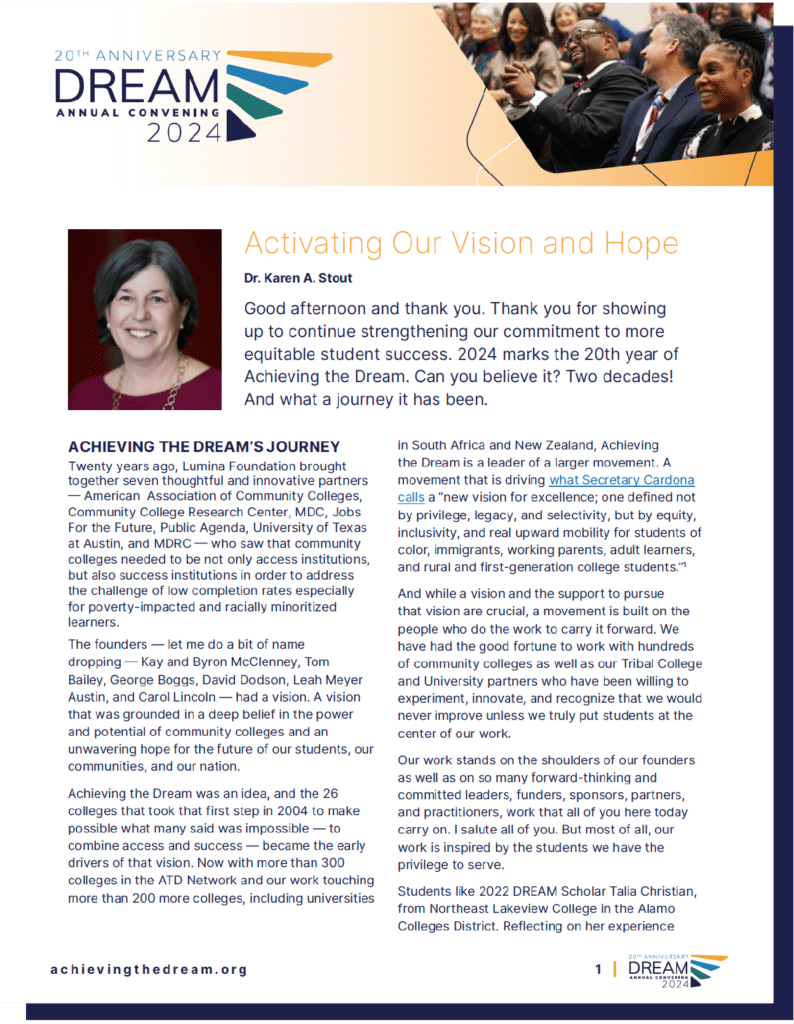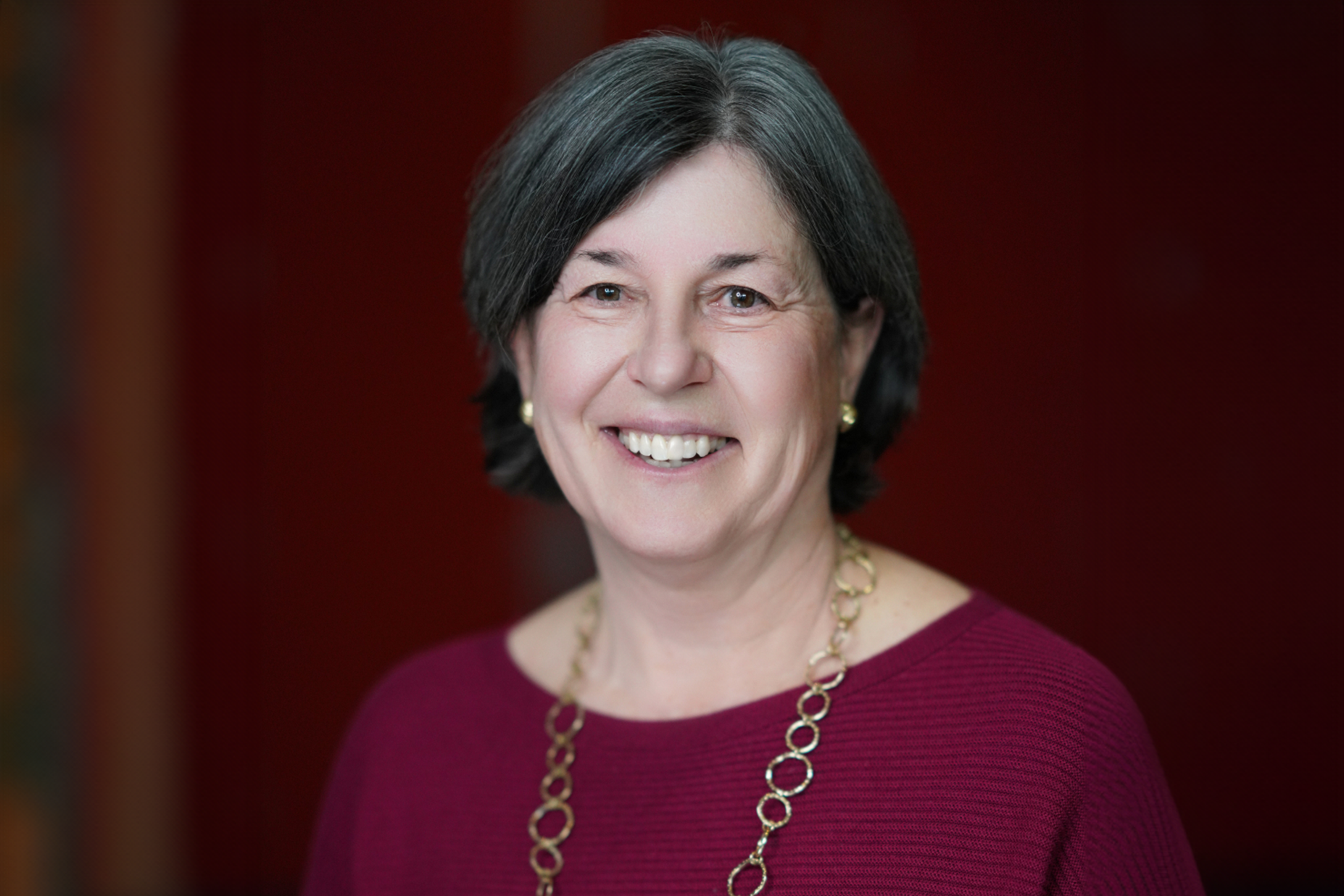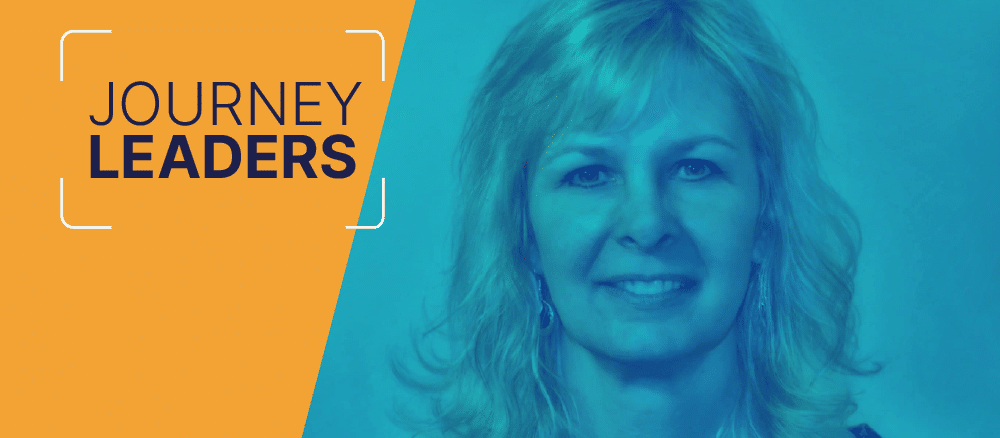Dr. Karen A. Stout’s Opening Remarks at DREAM 2024
Good afternoon and thank you. Thank you for showing up to continue strengthening our commitment to more equitable student success. 2024 marks the 20th year of Achieving the Dream. Can you believe it? Two decades! And what a journey it has been.
Achieving the Dream’s Journey
Twenty years ago, Lumina Foundation brought together seven thoughtful and innovative partners — American Association of Community Colleges, Community College Research Center, MDC, Jobs For the Future, Public Agenda, University of Texas at Austin, and MDRC — who saw that community colleges needed to be not only access institutions but also success institutions, in order to address the challenge of low completion rates especially for poverty-impacted and racially minoritized learners.
The founders — let me do a bit of name dropping — Kay and Byron McClenney, Tom Bailey, George Boggs, David Dodson, Leah Meyer Austin, and Carol Lincoln — had a vision. A vision that was grounded in a deep belief in the power and potential of community colleges and an unwavering hope for the future of our students, our communities, and our nation.
Achieving the Dream was an idea, and the 26 colleges that took that first step in 2004 to make possible what many said was impossible — to combine access and success — became the early drivers of that vision. Now with more than 300 colleges in the ATD Network and our work touching more than 200 more colleges, including universities in South Africa and New Zealand, Achieving the Dream is a leader of a larger movement. A movement that is driving what Secretary Cardona calls a “new vision for excellence; one defined not by privilege, legacy, and selectivity, but by equity, inclusivity, and real upward mobility for students of color, immigrants, working parents, adult learners, and rural and first-generation college students.’’
And while a vision and the support to pursue that vision are crucial, a movement is built on the people who do the work to carry it forward. We have had the good fortune to work with hundreds of community colleges as well as our Tribal College and University partners who have been willing to experiment, innovate, and recognize that we would never improve unless we truly put students at the center of our work.
Our work stands on the shoulders of our founders as well as on so many forward-thinking and committed leaders, funders, sponsors, partners, and practitioners, work that all of you here today carry on. I salute all of you. But most of all, our work is inspired by the students we have the privilege to serve.
Students like 2022 DREAM Scholar Talia Christian, from Northeast Lakeview College in the Alamo Colleges District. Reflecting on her experience at DREAM, Talia said, “I realized that while we’re making progress by continuing to develop the systems in place, we also need to realize that innovation is essential if we want to make life-changing impacts in community college systems. And that begins with a genuine desire to change.”
Talia defines one of the core characteristics of the ATD Network: innovation. We have a “genuine desire to change.” You see that spirit in the way that our approach to student success has evolved over time.
- We have shifted our work from looking at designing specific and often siloed interventions to recognizing the processes, structures, and attitudes that need reinvention to drive whole-college transformation.
- We shifted from looking at completion as the key success metric to looking at what that completion leads to — social and economic mobility that is an engine of community vibrancy. As we transform, our communities transform.
- We have circled back to understand that if we are truly going to help students and communities, we need to radically rethink our access agenda and the assumption that access is in our community college “DNA.”
- We have deepened our work to focus on key drivers of success and transformation across all aspects of what our colleges do. That work is wide ranging — from creating holistic student support systems to promoting cultures of teaching and learning excellence, and from broadening how we use data to drive equitable decision-making on campus to building boundary-spanning partnerships that connect us more deeply with our communities.
Our collective work over the last 20 years is remarkable, and you will see that remarkableness in action throughout this week, as there is no other higher education convening quite like DREAM. What will run through this conference, what is at the center of ATD’s work and has been since day one, is our unwavering commitment to equity and centering student voices in our work. These commitments call us to create a better, more equitable future for our students and the communities we serve.
A Commitment to Equity and Student-Centered Work
Even though it may be hard to hold on to that vision, this commitment is even more important now — especially since the divisive rhetoric we face around diversity, equity, and inclusion is an attack on the very students we serve. We must remember that the work we are doing has real impact. The data shows us that we have moved forward. ATD Network colleges are leaders in the field, helping larger percentages of students reach their college goals.
But the data also tells us that we have more work to do, as racial, economic, and social inequities persist by almost any measure, and those who suggest otherwise are simply ignoring the facts.
31 cents
Thirty-one cents is what, according to the St. Louis Federal Reserve, families headed by someone with some college education (but no four-year degree) had for every $1 of wealth held by families headed by a four-year college graduate. It drops to 22 cents for families headed by someone with a high school diploma.
19 cents
Nineteen cents is what Hispanic families owned on average for every $1 of white family wealth in 2023; Black families only owned 24 cents.
300,000
300,000 is the number of Black learners lost from our nation’s community colleges over the last two decades — meaning Black student enrollment is now back to the levels it was at the beginning of this century.
74 percent
Seventy-four percent more over a lifetime is what bachelor’s degree holders expect to earn over someone with a high school diploma.
This does not tell the whole story. Even when students attain equivalent college credentials, “race/ethnicity and gender are wild cards that matter more than education or occupation in determining earnings.” Women earn less than men, and Black and Latinx workers earn less than white and Asian peers at every level of educational attainment. We have an education system that provides inequitable access, support, and opportunity, resulting in less student success for marginalized students, perpetuating a gendered and racialized wealth gap.
We know that these inequities are not limited to selective universities, but they run throughout our education system — from K–12 through college, including our own institutions. I often point to research by the Brookings Institution which, based on program-level earnings data and student loan repayment outcomes at more than 1,200 community colleges, found that racially minoritized students are disproportionately enrolling in programs with lower earnings and that “colleges that enroll proportionally more underrepresented minority students tend to offer fewer programs in fields that lead to the highest post-college earnings.” We have our own work to do in how we design programs that truly serve students equitably.
Activating Vision and Hope for the Future
The question is: How can we activate our vision and our hope for the work ahead of us? How do we continue to find ways to lift up and support the needs of the students and communities we serve?
How do we understand what I heard Imani Perry describe in an interview as our nation’s “choreography of two steps forward, one step back . . . or sometimes three steps back”? And how do we, as Perry describes her work, use our history and culture and inquiry to move toward freedom, knowing that retrenchment will happen?
We know that no policy or statute or court ruling can take away our commitment to transformational change that eliminates systemic barriers, addresses student needs, and thus increases equitable student success.
I am reminded of what Thurgood Marshall said in his dissent to the 1974 Milliken v. Bradley Supreme Court decision, which effectively allowed our system of school districts to continue to be structurally segregated. Marshall said that it is the right of all students, “whatever their race, to an equal start in life and to an equal opportunity to reach their full potential as citizens.” He stated unequivocally that “[t]hose children who have been denied that right in the past deserve better than to see fences thrown up to deny them that right in the future.”
That is our challenge as we meet here in Florida — a state where policymakers have turned education into a battleground, where retrenchment has become public policy. When we released our equity statement, we stated clearly that we stand with marginalized students and that if we were going to advance student success, ensuring equity was paramount.
Nothing has changed about that commitment.
We are here in Florida to stand with and for all our students, faculty, staff, and leaders. We are here in Florida to stand with the communities that prosper because of the success of our students. We are here in Florida to demonstrate our commitment to equity-centered educational policies and practices because they are essential in supporting our students to success.
We have much work to do, both in our institutions and our communities. Work that must be informed by an honest assessment of our history and where we are. As Justice Sonia Sotomayor said in her dissenting opinion on the Supreme Court’s 2022 affirmative action ruling, “Ignoring race will not equalize a society that is racially unequal. What was true in the 1860s, and again in 1954, is true today: Equality requires acknowledgment of inequality.”
Of course, inequality takes many forms, and we know that our students and members of our communities are marginalized and excluded based on the intersections of race, gender identity, sexual orientation, ability, socioeconomic status, and religion. Our challenge is not just to acknowledge these inequalities but to dismantle them — to do what Thurgood Marshall called for — to tear down the fences of inequity in our classrooms, our policies and programs, our institutions, and our communities as a whole and replace them with a vision built on a common purpose.
I say communities because our work to build that common purpose cannot be limited to the boundaries of our campuses. Our institutions, our community colleges, were founded to make higher education more democratic and to strengthen our democracy. We must be drivers of collective impact. To do that means we have to be in our communities in multiple roles — as partners, as supporters, as leaders — whatever is needed to create the conditions for a more equitable and just society.
Hope requires not only a vision — an ideal endpoint — but also markers along the way that let us know we are heading in the right direction and renew our courage to keep going. The work you do every day, the work we do here together, the work we do with our partners, is propelled by our collective commitment to drive equitable change. We will constantly look to the markers that feed our collective hope, that further our progress, and that shape our resolve to keep moving to a more ideal endpoint.
DREAM is about renewing our commitment to supporting you and your institutions as you work to create equitable and economically vibrant communities. It is about driving forth with the mechanisms of change we know to shape the future of our students and communities. We cannot be satisfied until we have transformed our institutions to fully reach and fully support every learner in our communities to success.
There is much we must do to bridge divides, to rebuild a common culture, to create a more perfect union, to continue this experiment in a democracy that has lasted far longer than any previous. We must continue to tear down the fences of injustice as well as the fences that keep us distant from the people we serve who need us wherever they are, lost in the oppressed, arrhythmic heart of our communities.
Our vision and hope today is equally as big and ambitious as the original hope and vision for ATD was 20 years ago, and it is equally as urgent. Can we do this? Can we break down the barriers? Can we ask new questions that will help us reach and rally the common purpose that we hear in our DREAM Scholars’ poems?
The founders of ATD met the moment. They found a purpose that could spark innovation and focus across an entire sector of higher education. This is now our moment. Can we continue to reinvent our colleges and communities to be more equitable places that secure the future for another 20 years and beyond?
President Obama, in his farewell address, noted that democracy requires a “basic sense of solidarity — that for all our outward differences, we are all in this together; that we rise or fall as one.” How can our equity work inspire solidarity rather than division?
I know, as I look out across the room full of wonderful educators and leaders, that this future is attainable. I know we can do it because of every one of you, and all the students you serve, and your colleagues who keep the vision and the hope alive in your communities, on your campuses, and in your homes.
Thank you for being here to work together to strengthen our institutions, our communities, our democracy, and our nation.






